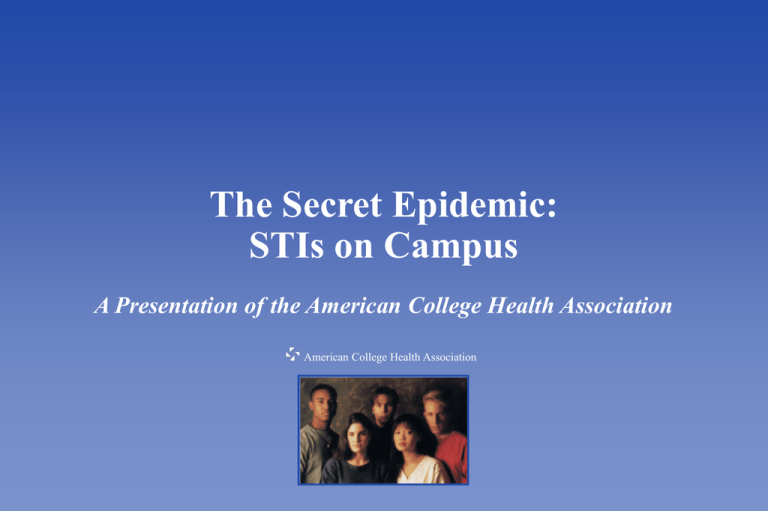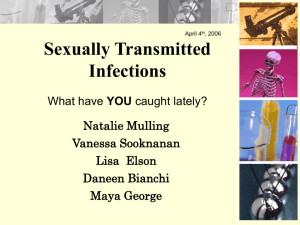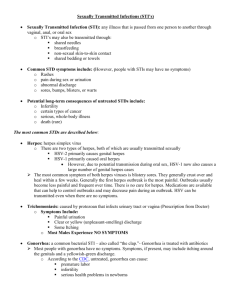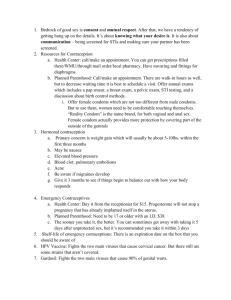
The Secret Epidemic:
STIs on Campus
A Presentation of the American College Health Association
American College Health Association
American College Health Association
Discussion Points for Today
Sexually Transmissible Infections (STIs)
Three Common STIs among Teens and Young Adults
The Most Common STI among Teens and Young Adults
What to do if you think you have an STI
American College Health Association
Infections—Generally Speaking
What are they?
• Overgrowths of bacteria, viruses, fungus (yeast), or protozoal
pathogens
How are they spread?
• Inhalation of infected air, contact with infected body fluids, contact
with infected skin (rashes, lesions)
How can they be prevented?
• Avoiding contact with infected air, fluids, and skin
American College Health Association
Sexually Transmissible Infections (STIs)
Also known as
• Sexually Transmitted Diseases (STDs)
• Venereal Diseases
What are your risks?
American College Health Association
Sexually Transmissible Infections
Bacterial Infections
• Chlamydia
• Gonorrhea
• Syphilis
Viral Infections
• Herpes
• Hepatitis B
• Molluscum contagiosum
• HIV
• Human papillomavirus
American College Health Association
Common STIs among Teens and Young Adults
Human Papillomavirus (HPV) (virus)
• Warts on genitals and anus (men and women)
• Warts and pre-cancers on cervix (women)
• Often asymptomatic, presenting no visible symptoms
• Communicable or non-communicable when asymptomatic
Chlamydia (bacteria)
• Infected cervix, tubes, epididymis
• Sometimes no symptoms at all
American College Health Association
Common STIs among Teens and Young Adults
Herpes (HSV I & II) (virus)
• Painful ulcers
• Often no symptoms at all
Molluscum Contagiosum (virus)
• Pimple-like lesions
• Often confused with pimples or folliculitis
American College Health Association
“Risky Contact” for the Spread of STIs
You don’t have to have sexual intercourse to contract an STI
• Many STIs are spread by direct skin contact
• Everyone who has “risky contact” is at risk
• Teens and young adults are more “at risk” than other populations
American College Health Association
“Risky Contact” for the Spread of STIs
Condoms do NOT completely protect from infections spread by
skin contact, because they do not cover all infected areas of the
skin
HPV
Herpes
Molluscum
Infection with these organisms does not require penetration
during intercourse if there is other “risky contact.”
American College Health Association
“Risky Contact” for the Spread of STIs
Avoid “risky contact,” which is any contact with skin or fluids
that may contain the viruses and bacteria that cause STIs
Don’t share intimate apparel such as swimwear or underwear
American College Health Association
Who gets STIs?
Anyone who has “risky contact” with a person with an STI
One contact might be all it takes to get an STI
The more contacts, the greater the risk
American College Health Association
STI Prevention
Abstinence works best
• Avoid genital touching
• Many teens and young adults are now choosing abstinence
• Abstinence reflects feelings of self worth and self esteem
• Not everyone is “doing it”
• Sexual activity is NOT a requirement for friendship or social
acceptance
American College Health Association
The Most Prevalent STIs
Chlamydia
Women: infects urethra, cervix
•
•
•
•
Often no symptoms
Sometimes pain with urination or lower abdominal pain
Infection can spread to tubes and ovaries
Can cause infertility
Men: infects urethra, epididymis
• Can cause pain with urination
• Swelling and pain of the testicles
Spread by body fluids
Semen
Vaginal
Anal
American College Health Association
Epididymitis due to Chlamydia - the swelling of this
infection is seen above the right testicle
American College Health Association
Hydrosalpinx resulting from Chlamydia - closed,
swollen and water-filled left tube in a young woman
American College Health Association
The Most Prevalent STIs
Genital herpes
Men and women: genital skin
• Extremely painful lesions
• Often no symptoms
Women: cervix
• Abnormal vaginal discharge
• Often no symptoms
• May infect newborns during delivery
Spread by skin contact
Genital-Genital
Hand-Genital
Oral-Genital
American College Health Association
Penis with vesicles (blisters) from genital herpes
American College Health Association
External genital skin of female with herpes ulcers
American College Health Association
The Most Prevalent STIs
Molluscum
• Can appear anywhere on the skin
• Bumps that look like pimples
• Can become infected with bacteria
Spread by body skin contact
Genital-Genital
Hand-Genital
Oral-Genital
American College Health Association
Molluscums of lower abdomen
American College Health Association
External genital skin of female with huge molluscums
American College Health Association
Human Papillomavirus (HPV)
Over 100 types of HPV
• More than 20 types of HPV can infect genital skin
• Men and women: genital and anal warts
• Women: lesions on the cervix and vagina
Spread by skin contact
Genital-Genital
Hand-Genital
Oral-Genital
American College Health Association
Human Papillomavirus (HPV)
HPV: Genital Warts
• Men and women: external genital skin, anus, in urethra
• Women: cervix, vaginal walls
• Condoms offer some protection, but don’t cover all of the skin that
can be infected
American College Health Association
Papillary genital warts of female
American College Health Association
Papillary genital warts of female
American College Health Association
Flat genital warts of male
American College Health Association
Papillary genital warts of male
American College Health Association
Papillary genital warts of male
American College Health Association
Papillary genital warts of male anus
American College Health Association
HPV Treatments
Treatments for External Genital Warts
Patient-applied prescription remedies
• Aldara™ (imiquimod) Cream, 5%
• Condylox™ gel 0.5% (podofilox)
Procedures performed in the doctor’s office
• Freezing–cryoprobe or liquid nitrogen
• Caustic chemicals–TCA, BCA, podophyllin
• Laser
American College Health Association
HPV and Pre-Cancers
Cervix and anus: some HPV types cause lesions that can
be pre-cancers
• If not treated, they can eventually become cancers
The Pap smear detects lesions on cervix
• Cells scraped from cervix are examined under a microscope
• If they have ever had sexual contact, women need yearly Paps
American College Health Association
Genital warts on cervix of female
American College Health Association
Pre-cancer changes on cervix
American College Health Association
HPV—Treatments of the Cervix and Anus
Cervix: destruction of lesion by freezing, laser, loop excision
• These treatments are about 90% successful
Anus: similar to external genital warts
• Aldara™, Condylox™, freezing, caustic chemicals, laser
American College Health Association
HPV Protection
Consistent condom use can cut down, but not eliminate, the
transmission of HPV
Many HPV-associated lesions resolve spontaneously, but they
may return
Warts can be treated and removed, but the virus may remain in
latent form
See your health care provider for an accurate diagnosis and
appropriate treatment
American College Health Association
What about HIV/AIDS?
HIV usually leads to AIDS
• AIDS is fatal—newer treatments prolong life, but not to a full life
expectancy
• Having an STI can increase the risk of acquiring HIV
• 2 in 1,000 young adults are HIV positive
• 92 in 1,000 young adults have chlamydia or HPV
HIV is spread by body fluids
Semen
Vaginal
Anal
American College Health Association
If you think you have an STI
See a health care professional
Be honest about your sexual behavior
Ask for explanations
If you do have an STI, notify your partner
American College Health Association
Testing for STIs
There is no single test that detects all STIs
No test is perfect (every test can fail to detect an infection)
Screening tests (used when no symptoms are present)
• HPV (visual examination; Pap smear tests the cervix only)
• Chlamydia, gonorrhea (tests of genital secretions or urine)
• HIV, syphilis (specific blood tests)
• There is no reliable test for herpes when symptoms are absent
American College Health Association
STI Prevention
Alcohol and Drugs contribute to becoming infected with an STI
Combined with sexual activity, the use of alcohol and other
drugs is strongly associated with:
• Sexual activity when you are not really ready
• The spread of STIs
• Unwanted/unplanned pregnancy
• Acquaintance/date rape
American College Health Association
Remember: Abstinence works best
Avoid genital touching
Many teens and young adults are choosing abstinence for now
(this does NOT mean life-long celibacy)
Abstinence reflects feelings of self worth and self esteem
Not everyone is “doing it”
Sexual activity is NOT a requirement for friendship or social
acceptance
American College Health Association
For more information about STIs, contact your health
service or other health care professional.
Visit the National HPV & Cervial Cancer Prevention Resource Center
at www.ashastd.org/hpv/hpvrc/toc.html
or contact ACHA at (410) 859-1500
American College Health Association








